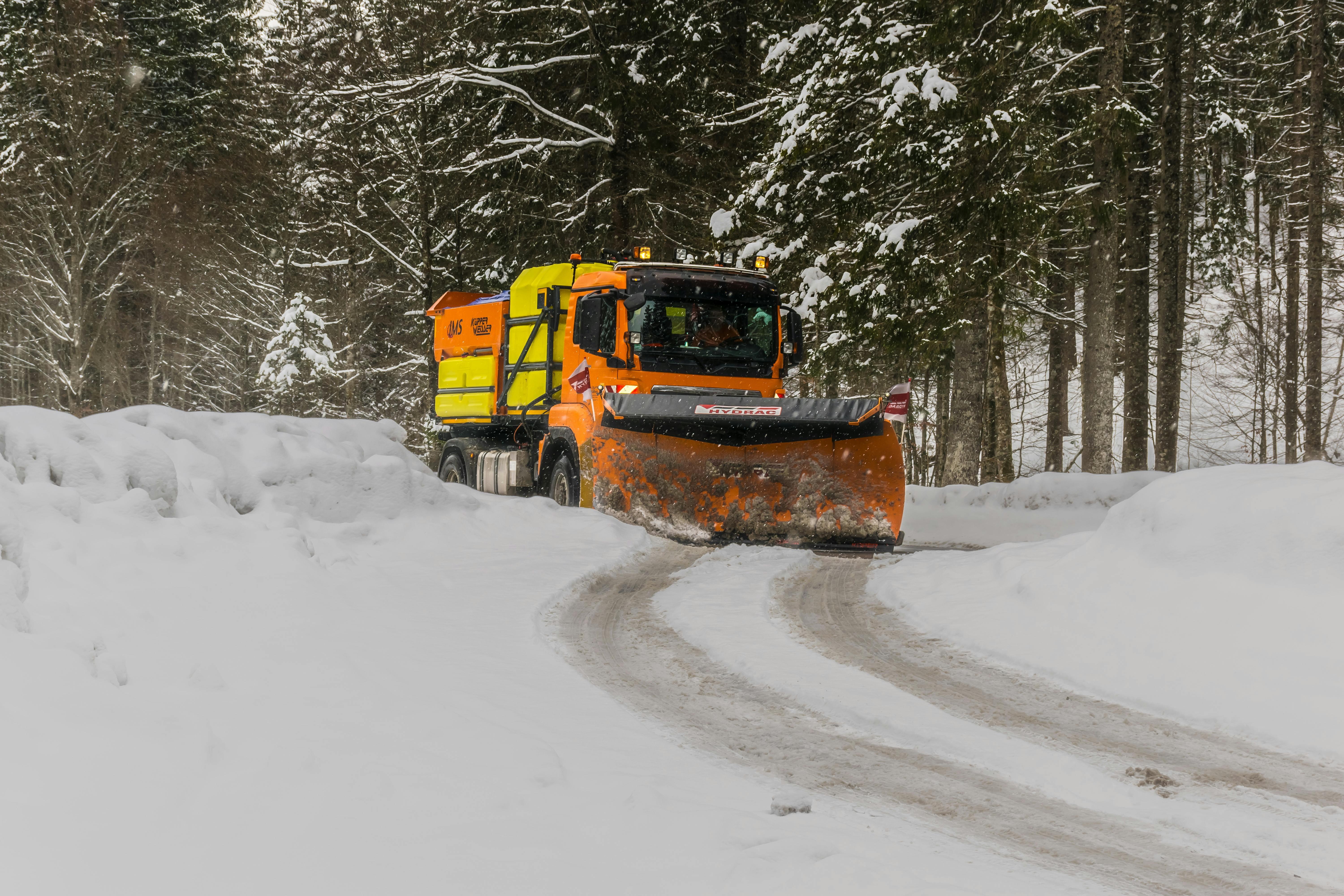Your Snow Plow Inspection Checklist: What to Do Before the Snow Starts to Fly
By Carly Bassett | in Uncategorized
Your Snow Plow Inspection Checklist: What to Do Before the Snow Starts to Fly
How familiar is this situation? It’s 5 AM, the snow started falling overnight, and you’re ready to clear your driveway or get to work plowing. You hop into your truck, attach your snow plow, and… nothing works. It sounds like a worst-case scenario, but unfortunately, it’s quite common. The good news? Avoiding this nightmare requires just a bit of preparation. Before the first snowflake falls, you need to set aside some time for a snow plow inspection. Whether you're a homeowner with a plow attachment or a seasoned snow plow operator, inspecting your equipment is not just a smart move that can help you get ahead this season - it’s something you should be doing if you care about the longevity of your plow. Thorough checks now can maximize your plow’s performance, prevent safety risks, and even save you money. Most importantly, you’ll have peace of mind knowing you’re ready for whatever grumpy Old Man winter throws your way.
Here’s everything you need to know to make sure your snow plow is up to the task, plus a step-by-step inspection checklist to help you get it done.
Why Do You Need to Inspect Your Plow?
Taking a proactive approach to snow plow maintenance isn’t just about avoiding inconvenience when you start your truck, ready to plow at 5 AM- it’s the key to staying efficient and safe all season. Here’s why investing time in a pre-season inspection is worth it:1. Maximize Performance
A well-maintained plow guarantees you’re clearing snow efficiently. From raised driveways to narrow roads, you need a plow that can handle it all without any hiccups. By making sure everything is functioning properly, from the hydraulics to the plow blade to the shoes, you’ll be able to tackle any plow job more effectively. Less guesswork, less tweaking, more snow-clearing.2. Improve Safety
Winter conditions are unforgiving. Icy roads, low visibility, and long shifts create enough challenges without having to worry about a malfunction. Conducting regular inspections reduces the risk of breakdowns or injury when you’re using your plow. No one wants to be stranded in the dark in below-freezing temps because of preventable issues. Inspecting brakes, hydraulic hoses, and mounting welds isn’t just good practice - it helps keep you (and everybody else) safe out there on the road.3. Save Money
Repairing a plow mid-season is expensive. A loose fastener could easily snowball into a major issue if left unchecked (not to mention that some parts are a bit cheaper in the off-season than they are when you find yourself in a wintery pinch). Regular checks can prevent costly damage or replacement of parts, making sure you get more mileage out of your equipment. Plus, addressing rust early or making small mechanical adjustments could save hundreds - or potentially thousands - in repair bills down the line.4. Long-Term Equipment Longevity
Snow plows are deliberately built tough because they have to handle tough conditions, but repeated impacts, exposure to salted roads, and extreme temperatures can take their toll over time. Seasonal maintenance slows the aging process, extending the life of both your plow and your truck. If you take care of your equipment, it’ll take care of you.5. Always Be Prepared
The last thing you want is to be caught off guard when the first snowstorm rolls in. A pre-season inspection ensures you’re ready to hit the ground running (or in this case, plowing).Your Snow Plow Inspection Checklist: What to Watch For
Grab your gloves, a flashlight, some dielectric grease, and this checklist - it’s time to get your plow winter-ready.1. Check Your Truck Battery, Wipers, Tires, and Brakes
Start with the essentials. Your truck’s battery should be fully charged, and the tires should have sufficient tread for icy roads. Inspect the wipers and make sure they’re clearing the windshield perfectly - snow visibility is key. Finally, give your brakes the green light so you can stop safely on slick surfaces.2. Run Through the Functions of the Plow
Think of it as a dress rehearsal for your plow - test everything before your first snow. Does the plow raise and lower smoothly? If you have a V-plow, make sure the wings extend and the blade pivots properly. Check the turn signals and beacon lights to make sure they’re working so you don’t have any surprises out there on the road.3. Inspect the Fasteners
Fasteners keep everything connected, so they need to be tight. Use a torque wrench to check all mounting bolts and fasteners for proper torque. Replace any missing or rusty bolts.4. Check Hydraulic Fluid Levels
Low hydraulic fluid is a common culprit for plow malfunctions. Top it off if needed and look for any leaks in the system that could cause you trouble later.5. Inspect the Plow for Rust or Corrosion
Road salt and moisture are a nightmare combination when it comes to metal parts. Inspect your plow for rust and touch it up with paint if necessary. For long-term protection, consider using a powder coating to act as a durable shield against corrosion.6. Inspect the Quick Couplers
Quick couplers should be clean and snap into place easily. Worn or damaged couplers can leak hydraulic fluid and affect plow performance.7. Look at the Wiring
Check your electrical connections, paying close attention to wear points. Clean all connections thoroughly and apply dielectric grease to prevent breakdowns caused by moisture or salt.8. Inspect the Plow Blade Edge and Shoes
The cutting edge of the plow is where the magic happens. Most manufacturers recommend replacing it if it’s less than 4 inches tall, has uneven wear, or is chipped. Also, take some time to inspect the plow’s shoes and replace them if they’re worn.9. Inspect the Springs
Inspect the plow’s trip springs for tension and any visible issues like cracks. Over time, they may weaken, requiring adjustment or replacement.10. Check the Hose Assemblies
Hydraulic hoses are prone to wear, so inspect for any cracks, crimps, or leaks. Replace worn hoses before they fail mid-job.11. Inspect the Clamps
Loose clamps can compromise the entire system. Make sure all clamps are securely holding hoses and wiring in place.12. Make Sure Nothing is Loose
Give everything a final once-over. Tighten any loose bolts or connections to eliminate small issues before they become big ones.13. Inspect the Welds in the Plow Structure and Vehicle Mount
Look for cracks or weaknesses in welds throughout the entire plow structure. Reinforce or repair any questionable welds to keep your plow working as designed.14. Test the Headlamps
Confirm your headlamps are functioning and aligned properly. Poor lighting can make nighttime plowing more hazardous than it needs to be.15. Make Sure Electric Plugs Have Dielectric Grease
Protect electrical plugs from moisture and corrosion by applying dielectric grease. It’s a quick, simple step to ensure reliable connections all season.16. Stock Your Emergency Supplies
This last tip might not be directly related to your plow, but it’s a smart step for anybody who has a plow: make sure you stock up. You should take a few moments to stock your vehicle with essentials like a shovel, emergency parts (hydraulic fluid, extra hoses, motor relay, etc.), a basic tool kit, and a flashlight. These items can save the day if something goes wrong (or at the very least, save you some time if and when you find yourself in a pinch).How to Store Your Snow Plow for Next Year
When spring rolls around, don’t just park that plow and forget about it. Clean it thoroughly to remove salt and grime. Inspect it for wear and tear, touch up any paint, and store it in a dry, covered space. For added protection, you should grease all moving parts and keep it elevated off the ground to prevent deforming the blade edge. A little TLC at the end of the season makes next winter’s prep much easier - and will make next year’s pre-season inspection go by so much more quickly, too. Preparing your snow plow before winter means making sure you’re ready for whatever comes your way. By following this checklist, you’ll save time, money, and headaches all season long. Need replacement parts or emergency supplies? Stock up now to avoid last-minute scrambles. Visit the Hose and Fittings shop to find everything you need for a successful season of pushing snow!FAQ
How do you maintain a snow plow?
Inspect your plow regularly for issues like rust, loose fasteners, and hydraulic leaks. Clean it after snow jobs to remove salt, grease moving parts, and replace worn parts when necessary.How often should you change plow fluid?
Ideally, you should check and change your hydraulic fluid at least once a year, or more frequently if you use your plow heavily.What do you spray on snow plow blades?
Anti-corrosion sprays or protectants can help prevent rust. Some also use WD-40 or specialized plow coatings.How do you keep a plow from rusting?
Touch up paint and use powder coating to create a barrier. Wash your plow after every snow job to remove salty residue.Relevant Link:
At HoseandFittings.com, we are dedicated to providing the best online customer service experience possible, complete with over 125,000 products cataloged for you. Our website has been designed with your needs in mind. You can quickly navigate through our departments with confidence and find the product you need to meet your requirements, with fast loading images and spec pages containing the details you need. HoseandFittings.com (HnF) was launched in 1999, created as an extension to the “bricks and mortar” company Power Components Corporation (PCC). Our goal is to help our consumers find the products they need at a price they can afford at HoseandFittings.com all from the convenience of their computer.

